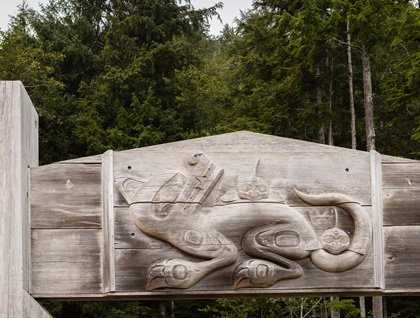Haida culture is rooted deeply in its stories. The story of Spirit Lake is no exception. In that story, the Wasco was a supernatural being, half wolf and half sea monster, that once lived in one of the lakes on the current day Spirit Lake Trail. It had access to the Skidegate Inlet and the ocean through an underground tunnel, where it would feed on whales. Each day it had to return to the lake for refuge before the raven called or it would cease to be a supernatural being. The Wasco had killed the eight brothers of a man named Nobel One Standing in a Moving Canoe. Mouse Woman told him to bathe in the ocean for strength to prepare to hunt the Wasco. He created a trap from fallen cedar trees and trapped the Wasco. With the medicine given to him from Mouse Woman, he was able to locate the bones of his brothers in the belly of the Wasco and bring them back to life. In trapping the Wasco, he made the area safe. As we approached the trailhead of Spirit Lake Trail, we passed under a large carving of the Wasco as a reminder of the area’s connection to this creature.
Knowledge about a place can come from many avenues and we explore several today. Museums have a wealth of information about artifacts, architecture, history, and local lore. Naturalist guides can inform us about the flora and fauna of a forest trail. Our cultural interpreter Linda Tollas was an excellent guide for Spirit Lake Trail, because of her intimate relationship with the area and because she was one of the people responsible for the establishment of the trail in 1996. Traditionally this trail was used by locals to collect berries and food. Now it is an established trail system where people still collect but also enjoy for exercise and to be out in the forest. As we walked along the trail with her, she pointed out ferns, trees, and plants that were used for food, medicine or other purposes. Ash from the red alder and false azalea were used for traditional tattoo ink. Red huckleberry stalks were shaped into pegs and nails for bentwood boxes. Numerous culturally modified trees, primarily red cedar trees, were located along the trail as well. The scars that they bear told stories of people that had come before to use these trees for weavings, buildings, and canoes. These along with the myriad plants used for food and medicine reminded us of the deep connection the Haida have with the forests around them.







